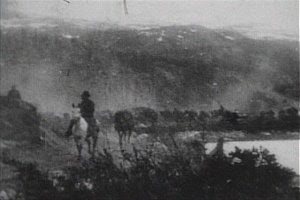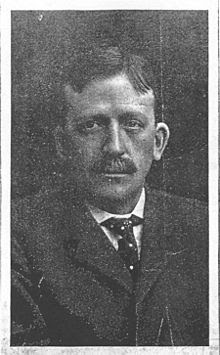 So who says you can’t put more than 2 cruise ships at the Railroad dock? Here in 1904 Case & Draper photographed 5 steamers tied up.
So who says you can’t put more than 2 cruise ships at the Railroad dock? Here in 1904 Case & Draper photographed 5 steamers tied up.
Shipwreck
Erastus Brainerd
Erastus Brainerd was an American journalist and art museum curator. During the Yukon Gold Rush, he was the publicist who “sold the idea that Seattle was the Gateway to Alaska and the only such portal”. He was born on February 25, 1855 in Middletown, Connecticut and attended Phillips Exeter Academy and Harvard University, from which he graduated at the age of 19. He served as curator of engravings at the Boston Museum of Arts, then traveled to Europe, where he promoted a tour for “lecturing showman” W. Irving Bishop. He was a social success in Europe, and became a Knight of the Order of St. John of Jerusalem, a Knight of the Red Cross of Rome, a Knight Templar, and a Freemason.
In July 1890, after recovering from three severe bouts of influenza, he headed west to become editor of the Seattle Press and the Press-Times, a role he held until September 1893. He left to focus on the office of State Land Commissioner, to which he had been appointed March 15, 1893. He joined the Rainier Club and organized a local Harvard Club. In 1897, as secretary and executive officer of the newly founded Bureau of Information of the Seattle Chamber of Commerce, he became the most prominent figure in the publicity campaign that established Seattle’s preeminence as a mercantile and outfitting center for the miners headed to the Yukon. He also convinced the federal government to open an assay office in Seattle. He briefly and unsuccessfully attempted to make a living as a “mining consultant” before becoming editor of the Seattle Post-Intelligencer. He may never have come to Skagway, but he certainly influenced the thousands that did. And so, we dub him a Skagway hero.
Brainerd died on December 25, 1922 in Tacoma, Washington.
Wikipedia; Library of Congress; National Park Service.
Draper photo
AYP photographer

Frank Nowell was the photographer for the AYPE and there are about 178 glass plate negatives of his photos left. Here is one which he took of Kaw Claa a Tlingit woman in her full potlach costume. I believe this is Susie Kah-kaka-klah who was born in 1884 and died at the age of 21 in Skagway, on July 12, 1904.
Skagway Death Record; 1900 census.
Ernest F. Keir

Ernest Keir was born on New Years Day, 1878 in Vernon Wisconsin.
In March 1898, Ernest and his brother set off from Wisconsin for the Yukon. Ernest used his 6.5″ x 8.5″ full-plate camera to record the trip and his stay in Dawson. Although an amateur, he managed to sell enough of his photographs, through a Dawson City drug store, to support himself in the Yukon. His biggest difficulty was in acquiring enough photographic supplies to keep in business. Keir left the north in 1900 and settled in Saskatchewan. He lost the negatives of his Yukon trip in 1913. He died also on New Years Day, 1941 and is buried in the Pines Cemetery in Spokane.
He is seen above in a cabin with some friends during the Gold Rush, he is at the far right. They are showing off their music collection of cylinders and Victrolas which helped to keep them sane in the long winters. Their version of ipods.
Movie at Chilkoot Pass

In 1898 Thomas Crahan and Robert K. Bonine, who worked for Thomas Edison came to Skagway and filmed a pack train at the Chilkoot Pass. The film shows eight loaded mules led by a man on horseback. Although it is only one minute long, filmed in summer, it is perhaps the earliest movie shot in this area. Seen above is a still from that film. Crahan went on to Dawson and did some filming there and then returned to Whitehorse to film rapids in 1900. The Klondike Exposition Company was organized by Edison and Thomas Crahan to make a filming expedition to the Yukon in order to produce films suitable for display at the Paris Exposition of 1900.
G.O.P. Headline 1921
Sylvestor Scovel
Of the many schemes to get rich, Sylvester Scovel’s was unique.
Scovel was a reporter for the New York World, but he also brought two tons of blasting powder to Skagway in Sept 1897 for White Pass Trail construction. He arrived in Skagway with his wife, Frances Cabanne and went over the Chilkoot Pass with their provisions. When he and Frances reached Lake Bennett, they had intended to float up to Dawson, but when he heard that only three mail deliveries would make it to Dawson that winter, Scovel came up with an idea. Why not organize a regular dog team mail delivery service from Skagway to Dawson and thus deliver the “New York World” to miners who would happily pay for news? He told Frances that they would certainly get rich.
Skeptics pointed out that the 600 miles of snow covered trails, frozen lakes and sub-zero conditions would take 25-30 days.
Still, Scovel told his wife that it would be like an extended honeymoon with nothing to do but “hunt, fish, prospect for gold and write correspondence…”
He left Frances in a tent at Lake Bennett while he hiked back to Skagway and took a boat down to Seattle to wire his employers for support in this venture. The World took three days to respond and then turned him down flatly and ordered him back to New York immediately. He wrote to Frances to return to Skagway and take the first boat down to Seattle as he was returning to New York. He also wrote to William Saportas, an acquaintance and fellow reporter in Skagway (also friend of Soapy) to please go find the “madame” in Lake Bennett and take her down south. Meanwhile poor Frances had not heard from her husband yet and so related in a letter to her mother that Bennett was “awful, awful without him and in this hole – it is death.”
Sylvester’s relatives in Chicago were amazed and told him he should not have left Frances. His Aunt Belle even boxed his ears! To make matters worse, the World was not happy and accused him of “gross extravagance” having wasted too much money. Oddly, the only reason he was not fired was because Hearst was courting him to come work for the New York Journal. Scovel went on to be the World’s “man in Havana”, but died there in 1905 following an operation to his liver.
In the end the only one who came out ahead was William Saportas. He married the lovely widow Frances in 1917 and they presumably lived happily ever after.
Seen above are Scovel and his wife Frances in Skagway promoting his newspaper!
The Year that defined American Journalism: 1897 and the clash of paradigms by W. Joseph Campbell; Edmond Hazard Wells, Magnificence and Misery, page 32.
NY Times Sept 6, 1897
Leonard Scofield Sugden

Doctor Leonard Sugden was born in June of 1873 in Scotland. He first came north on a whaling vessel and practiced in Juneau. In 1897, he headed for the Klondike but had to winter at Marsh Lake, where he built a cabin and worked as a doctor for the NWMP. When the real gold rush began in 1898, he helped pilot boats through Miles Canyon and the White Horse Rapids. Dr. Sugden stayed in the Yukon. He was the inspiration for Robert Service’s poem, the Cremation of Sam McGee when Service heard of the story of Dr. Sugden hauling a corpse to Tagish and contacting the family in Tennessee to get permission to cremate the remains.
Sam Steele mentioned in his memoirs that Dr. Sugden once hauled a woman 100 miles on a sled to get her to medical help and safety.
Dr. Sugden married in 1906 and moved to the Kluane area where he mined, hunted big game and bought a Prizma movie camera. With it he produced, in 1915, a film called The Lure of Alaska which played to rave reviews across America and Europe.
The film includes shots from the Seattle harbor and along the coast of Alaska and features scenes of Juneau, Sitka, Skagway, a midnight baseball game in Dawson City, a caribou herd swimming in the river, and icebergs calving from glaciers. The movie also includes scenes of Sugden piloting a raft through the Whitehorse Rapids.
The New York Times in 1917 wrote:
“Seldom have nature pictures been such a combination of thrills and wild beauty. They are a notable accomplishment of the camera and Dr. Sugden’s nerve.”
Unfortunately, Dr. Sugden’s life of adventure ended suddenly in 1923 when he fell off a barge into the Stewart River near Mayo and drowned. He was 50 years old.
A CKRW Yukon Nugget by Les McLaughlin



